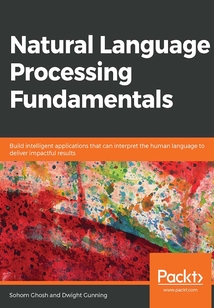舉報(bào) 

會(huì)員
Natural Language Processing Fundamentals
最新章節(jié):
Chapter 8: Sentiment Analysis
IfNLPhasn'tbeenyourforte,NaturalLanguageProcessingFundamentalswillmakesureyousetofftoasteadystart.ThiscomprehensiveguidewillshowyouhowtoeffectivelyusePythonlibrariesandNLPconceptstosolvevariousproblems.You'llbeintroducedtonaturallanguageprocessinganditsapplicationsthroughexamplesandexercises.Thiswillbefollowedbyanintroductiontotheinitialstagesofsolvingaproblem,whichincludesproblemdefinition,gettingtextdata,andpreparingitformodeling.Withexposuretoconceptslikeadvancednaturallanguageprocessingalgorithmsandvisualizationtechniques,you'lllearnhowtocreateapplicationsthatcanextractinformationfromunstructureddataandpresentitasimpactfulvisuals.AlthoughyouwillcontinuetolearnNLP-basedtechniques,thefocuswillgraduallyshifttodevelopingusefulapplications.Inthesesections,you'llunderstandhowtoapplyNLPtechniquestoanswerquestionsascanbeusedinchatbots.Bytheendofthisbook,you'llbeabletoaccomplishavariedrangeofassignmentsrangingfromidentifyingthemostsuitabletypeofNLPtaskforsolvingaproblemtousingatoollikespacyorgensimforperformingsentimentanalysis.Thebookwilleasilyequipyouwiththeknowledgeyouneedtobuildapplicationsthatinterprethumanlanguage.
目錄(68章)
倒序
- 封面
- 版權(quán)頁(yè)
- Preface
- About the Book
- Chapter 1 Introduction to Natural Language Processing
- Introduction
- History of NLP
- Text Analytics and NLP
- Various Steps in NLP
- Kick Starting an NLP Project
- Summary
- Chapter 2 Basic Feature Extraction Methods
- Introduction
- Types of Data
- Cleaning Text Data
- Feature Extraction from Texts
- Feature Engineering
- Summary
- Chapter 3 Developing a Text classifier
- Introduction
- Machine Learning
- Developing a Text Classifier
- Building Pipelines for NLP Projects
- Saving and Loading Models
- Summary
- Chapter 4 Collecting Text Data from the Web
- Introduction
- Collecting Data by Scraping Web Pages
- Requesting Content from Web Pages
- Dealing with Semi-Structured Data
- Summary
- Chapter 5 Topic Modeling
- Introduction
- Topic Discovery
- Topic Modeling Algorithms
- Summary
- Chapter 6 Text Summarization and Text Generation
- Introduction
- What is Automated Text Summarization?
- High-Level View of Text Summarization
- TextRank
- Summarizing Text Using Gensim
- Summarizing Text Using Word Frequency
- Generating Text with Markov Chains
- Summary
- Chapter 7 Vector Representation
- Introduction
- Vector Definition
- Why Vector Representations?
- Summary
- Chapter 8 Sentiment Analysis
- Introduction
- Why is Sentiment Analysis Required?
- Growth of Sentiment Analysis
- Tools Used for Sentiment Analysis
- TextBlob
- Understanding Data for Sentiment Analysis
- Training Sentiment Models
- Summary
- Appendix
- Chapter 1: Introduction to Natural Language Processing
- Chapter 2: Basic Feature Extraction Methods
- Chapter 3: Developing a Text classifier
- Chapter 4: Collecting Text Data from the Web
- Chapter 5: Topic Modeling
- Chapter 6: Text Summarization and Text Generation
- Chapter 7: Vector Representation
- Chapter 8: Sentiment Analysis 更新時(shí)間:2021-06-11 13:42:47
推薦閱讀
- Ansible Configuration Management
- Dreamweaver CS3+Flash CS3+Fireworks CS3創(chuàng)意網(wǎng)站構(gòu)建實(shí)例詳解
- 樂(lè)高機(jī)器人:WeDo編程與搭建指南
- 火格局的時(shí)空變異及其在電網(wǎng)防火中的應(yīng)用
- LabVIEW虛擬儀器從入門到測(cè)控應(yīng)用130例
- 手把手教你學(xué)AutoCAD 2010
- 電腦上網(wǎng)直通車
- 群體智能與數(shù)據(jù)挖掘
- 深度學(xué)習(xí)中的圖像分類與對(duì)抗技術(shù)
- 自動(dòng)化控制工程設(shè)計(jì)
- Docker High Performance(Second Edition)
- Working with Linux:Quick Hacks for the Command Line
- 三菱FX/Q系列PLC工程實(shí)例詳解
- Web璀璨:Silverlight應(yīng)用技術(shù)完全指南
- 計(jì)算智能算法及其生產(chǎn)調(diào)度應(yīng)用
- 工業(yè)機(jī)器人集成應(yīng)用
- 與人共融機(jī)器人的關(guān)節(jié)力矩測(cè)量技術(shù)
- 基于Proteus的PIC單片機(jī)C語(yǔ)言程序設(shè)計(jì)與仿真
- Redash v5 Quick Start Guide
- Generative Adversarial Networks Projects
- ARM體系結(jié)構(gòu)與編程
- 工廠電氣控制設(shè)備
- iLike職場(chǎng)大學(xué)生就業(yè)指導(dǎo):C和C++方向
- 數(shù)字媒體交互設(shè)計(jì)原理與方法
- 工業(yè)機(jī)器人技術(shù)基礎(chǔ)
- 計(jì)算機(jī)控制技術(shù)(MCGS實(shí)現(xiàn))
- Excel 2010行政與文秘應(yīng)用
- 機(jī)器學(xué)習(xí)技術(shù)及應(yīng)用
- Troubleshooting OpenStack
- 單片機(jī)原理及應(yīng)用

